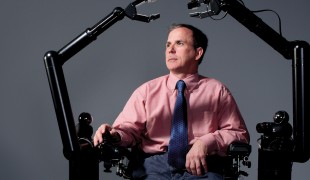- 4722
- 281
- 15
- 12
- 0
- Help Ukraine
About the solution
The solution consists of a wooden device which has two functions: to hold the book and keep it open, and to allow the user to turn the pages.
“First, the bookend should be tilted slightly so that the book does not lie flat. Otherwise grandmother had to bend over to read and she can’t. Secondly, I had to think of something to keep the pages in place and make sure the text is not covered. That's why I got the idea to use a transparent material (plexiglass). The plexiglass glued to a wooden slat fits on the two sides of the bookend in a slot. So you can move them, depending on the size of the book. The stand itself is made from a sheet of plywood. Then two wooden slats glued to the slot”, the inventor described.
Nette’s grandmother had a road accident and became totally paralyzed, being able to use only her right arm and wrist.
She loves to read, but has a hard time turning the pages and keep a book open. So her granddaughter Nette stepped in and invented a book holder which allows the book to stay open on the right page.
Using the help of her grandfather, who, years earlier had already made a small rod with a non-slip end to turn the pages and helped with the materials, she created a device which allows the user to keep the book open and turn the pages.
According to Nette, the invention is also adapted to people who suffer from limited finger movement following an accident or a disease, in particular patients suffering from Multiple Sclerosis, Muscular diseases, Paralysis, etc.
You can check the attached file with drawings and instructions.
Adapted from: http://bit.ly/2mINTLZ
This solution shall not include mention to the use of drugs, chemicals or biologicals (including food); invasive devices; offensive, commercial or inherently dangerous content. This solution was not medically validated. Proceed with caution! If you have any doubts, please consult with a health professional.
DISCLAIMER: This story was written by someone who is not the author of the solution, therefore please be advised that, although it was written with the utmost respect for the innovation and the innovator, there can be some incorrect statements. If you find any errors please contact the patient Innovation team via info@patient-innovation.com
-
-
307
-
0
-
5604

Paralyzed man designs innovative wheelchairs
CAREGIVING
MOVING IN A WHEELCHAIR: Moving using a wheelchair.
Grip
Rubgy
Basketball
Paralysis
Cervical spinal cord injury/Tetraplegia
Assistive Daily Life Device (to help ADL)
Assistive Technology access
Walking Aid (wheelchair/walker/crutches)
Restoring mobility
Replacing lost limbs
Promoting self-management
Promoting inclusivity and social integration
Recovering from Traumatic Injuries
Preventing (Vaccination, Protection, Falls, Research/Mapping)
Caregiving Support
Neurology
Orthopedics
Physical Medicine and Rehabilitation
United States
-
-
-
120
-
0
-
1314

Collaborator James Leckey makes equipment to improve the quality of life and social inclusion of children with special needs
MOVING IN A WHEELCHAIR: Moving using a wheelchair.
BODY BALANCE: Maintaining body balance
STANDING UP: Standing up from a seated position
Playing
Neuromuscular Disorders
Assistive Daily Life Device (to help ADL)
Walking Aid (wheelchair/walker/crutches)
Assistive Technology access
5 Senses support devices: (glasses, hearing aids, headphones...)
Restoring mobility
Promoting self-management
Managing Neurological Disorders
Promoting inclusivity and social integration
Maintaining Balance and Mobility
Raise awareness
General and Family Medicine
Neurology
Orthopedics
Pediatrics
Physical Medicine and Rehabilitation
United States
-
-
-
420
-
0
-
7579

Man creates device to help to put on socks, shoes and even trousers
Grip
(SELF)-CARE: DRESSING: Dressing independently.
BODY BALANCE: Maintaining body balance
STANDING UP: Standing up from a seated position
Knee Deformity
Assistive Daily Life Device (to help ADL)
Strategy/Tip
Muscle weakness
Limited range of motion
Muscle pain or stiffness
Reduced grip force (grip)
Loss of muscle coordination
Muscle cramps or spasms
Joint deformity
Joint redness or warmth
Swelling or inflammation
Difficulty bearing weight
Muscle twitching
Difficulty standing from a seated position
Difficulty getting up from the floor
Numbness or tingling in the extremities
Joint pain or swelling
Restoring mobility
Promoting self-management
Preserving Organ Function
Rehabilitating After Stroke
Managing Neurological Disorders
Recovering from Traumatic Injuries
Maintaining Balance and Mobility
Preventing (Vaccination, Protection, Falls, Research/Mapping)
Caregiving Support
Internal Medicine
Neurology
Orthopedics
Physical Medicine and Rehabilitation
Rheumatology
Sports Medicine
Vascular Surgery
United States
-
 en
en